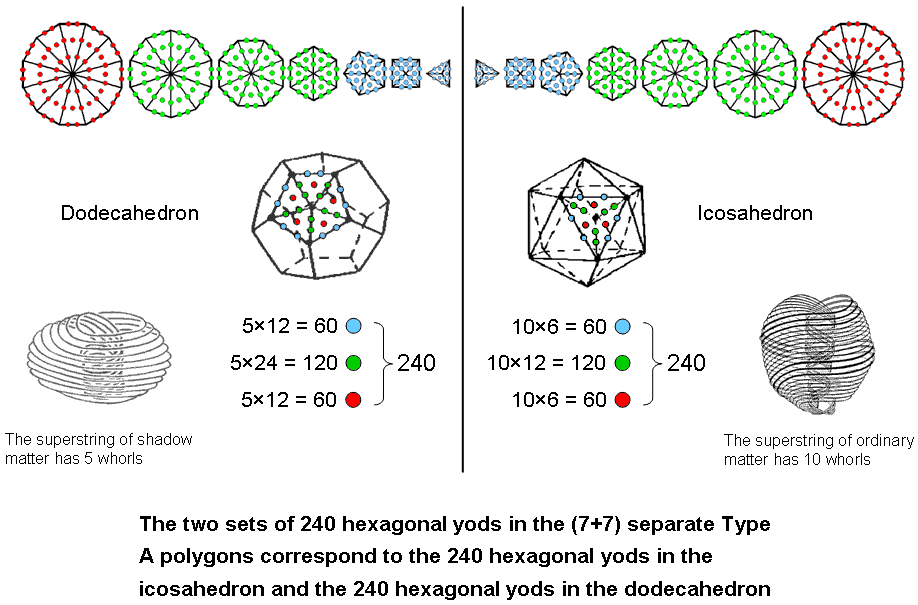
| << Previous 1... 4 5 6 7 [8] Next >> |
Ten-fold division of the hexagonal yod population of the icosahedron
Just as the dodecahedron has a natural, 5-fold distribution of the 240 hexagonal yods in its faces, so its dual — the icosahedron — has a natural, 10-fold distribution of the 240 hexagonal yods in its faces, as now shown.

Inner Tree of Life
There are five hexagonal yods per sector of a Type A polygon. The triangle, square & pentagon have 12 sectors
with 60 blue hexagonal yods that form five groups of 12 (each blue hexagonal yod of a given type is repeated 12
times). The dodecagon also has 12 sectors with 60 red hexagonal yods that form five groups of 12, each type of
hexagonal yod being repeated 12 times. Hence, these four polygons have 120 hexagonal yods forming five groups of
(12+12=24). The hexagon, octagon & decagon have 24 sectors with 120 green hexagonal yods that form five
groups of 24. A group of 24 green hexagonal yods consists of 12 and their counterparts in the sectors on the
opposite side of a polygon, so that they form 10 sets of 12. The seven polygons have 240 hexagonal yods that form
10 groups of 24.
Icosahedron
Five edges meet at each vertex. Two blue hexagonal yods lie on each edge,
so that five blue hexagonal yods can be associated with each of the 12 vertices. The 30 edges have (30×2=60) blue
hexagonal yods. The 12 vertices are six pairs of diametrically opposite vertices, so that the 60 blue hexagonal
yods form six pairs of five. This may be regarded as five pairs of six, i.e., as 10 sets of six blue hexagonal
yods. A red hexagonal yod is at the centre of each tetractys sector of a triangular face. The 20 faces have
(20×3=60) red hexagonal yods. They belong to 10 pairs of diametrically opposite faces, each pair having six red
hexagonal yods. Six green hexagonal yods line sides of tetractyses inside each face. Each pair of faces has 12
green hexagonal yods, so that the 120 green hexagonal yods form 10 sets of 12 hexagonal yods. The icosahedron has
240 hexagonal yods that form 10 sets of 24 (six blue, six red & 12 green).
Comparing the distributions of hexagonal yods in the seven polygons and in the icosahedron, we see that they both have 240 hexagonal yods that form 10 sets of 24. This 10-foldness manifests in the subatomic world as the 10 whorls of the UPA, the spin-½ subquark state of the E8×E8′ heterotic superstring, 24 gauge charges of E8 being spread along each of its closed curves. The diagram compares this 10-fold distribution of the 240 hexagonal yods with their alternative five-fold distribution discussed on the previous page. One set of seven polygons encodes E8 and the 10-fold structure of the UPA, the basic superstring constituent of ordinary matter remote-viewed by Annie Besant & C.W. Leadbeater over a century ago (see Occult Chemistry). The mirror image set of seven polygons encodes E8′ and the five-fold structure of the basic superstring constituent of shadow matter, the equally fundamental type of matter predicted by E8×E8′ heterotic superstring theory. The diagram opposite depicts this particle as observed and drawn by a Canadian clairvoyant who believes that he possesses the yogic siddhi of micro-psi (private communication). The icosahedron and its dual — the dodecahedron — embody the number 240 as a defining parameter of all holistic systems. But they do so in two different ways — respectively, either as 10 sets of 24 hexagonal yods or as five sets of 48 hexagonal yods; these patterns manifest as the 10 whorls of the superstring of ordinary matter and as the five whorls of the superstring of shadow matter. The dual nature of these two regular polyhedra is responsible for the symmetry group of the unified superstring force having the form of the direct product of two similar symmetry groups. Other examples of this embodiment are discussed here.
| << Previous 1... 4 5 6 7 [8] Next >> |